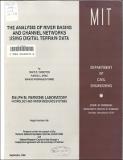| dc.contributor.author | Tarboton, David G. | en_US |
| dc.contributor.author | Bras, Rafael L. | en_US |
| dc.contributor.author | Rodriguez-Iturbe, Ignacio | en_US |
| dc.date.accessioned | 2022-06-13T13:14:07Z | |
| dc.date.available | 2022-06-13T13:14:07Z | |
| dc.date.issued | 1989-09 | |
| dc.identifier | 326 | |
| dc.identifier.uri | https://hdl.handle.net/1721.1/143071 | |
| dc.description | Prepared under the support of the National Science Foundation ECE-8513556. Prepared under the support of the National Research Council of Italy through a cooperative agreement with the University of Florence. | en_US |
| dc.description.abstract | This work examines patterns of regularity and scale in landform and channel networks. Digital elevation model data sets from throughout the United States are used as a data source. First we consider the two-dimensional planform properties of channel networks. We find that networks as a whole may be regarded as space filling fractals, ie.., with fractal dimension 2. The scaling may be described by Horton's laws and provides a link between Horton length and bifurcation ratios. Second we focus on elevation where the mean slope of rivers is characterized by a power law scaling with area. Investigations have recently used this to suggest that channel slopes are self-similar with magnitude or area as a scaling index. Our data indicates otherwise; in particular the variance of channel slope is larger than that predicted by simple self-similarity. The coefficient of variation of link slopes increases with area contributing to the link. This suggests multi-scaling. The scaling exponent for the standard deviation is approximately half the corresponding exponent in the relationship of the slope mean to magnitude or area. A model for channel slopes based on a point process of elevation drops along the channel is suggested. This model reproduces the observed multi-scaling properties when the density of elevation increments is related to area (or magnitude) as A-0. This scaling cannot hold in the limit of small area and must break at some point. We suggest that this break defines the lower bound scale for which channels exist and can therefore be used to determine the drainage density, the basic horizontal length scale associated with the dissection of the landscape by the channel network. This break in scale can also be detected as a break in the constant drop property, namely the empirical fact that the elevation drop along Strahler streams is on average constant. That the break in scale gives drainage density is justified using a stability analysis of landform development processes and empirical comparison of drainage densities from many DEM data sets. This work provides a rational way to extract channel networks with physically justifiable drainage density from digital elevation models. | en_US |
| dc.publisher | Cambridge, Mass. : Ralph M. Parsons Laboratory, Hydrology and Water Resource Systems, , Massachusetts Institute of Technology, Dept. of Civil Engineering | |
| dc.relation.ispartofseries | R (Massachusetts Institute of Technology. Department of Civil Engineering) ; 89-24. | |
| dc.relation.ispartofseries | Report (Ralph M. Parsons Laboratory for Water Resources and Hydrodynamics) ; 326. | |
| dc.relation.uri | https://hdl.handle.net/1721.1/39956 | |
| dc.title | The Analysis of River Basins and Channel Networks Using Digital Terrain Data | en_US |
| dc.identifier.oclc | 21467806 | |
| dc.identifier.aleph | 411649 | |
